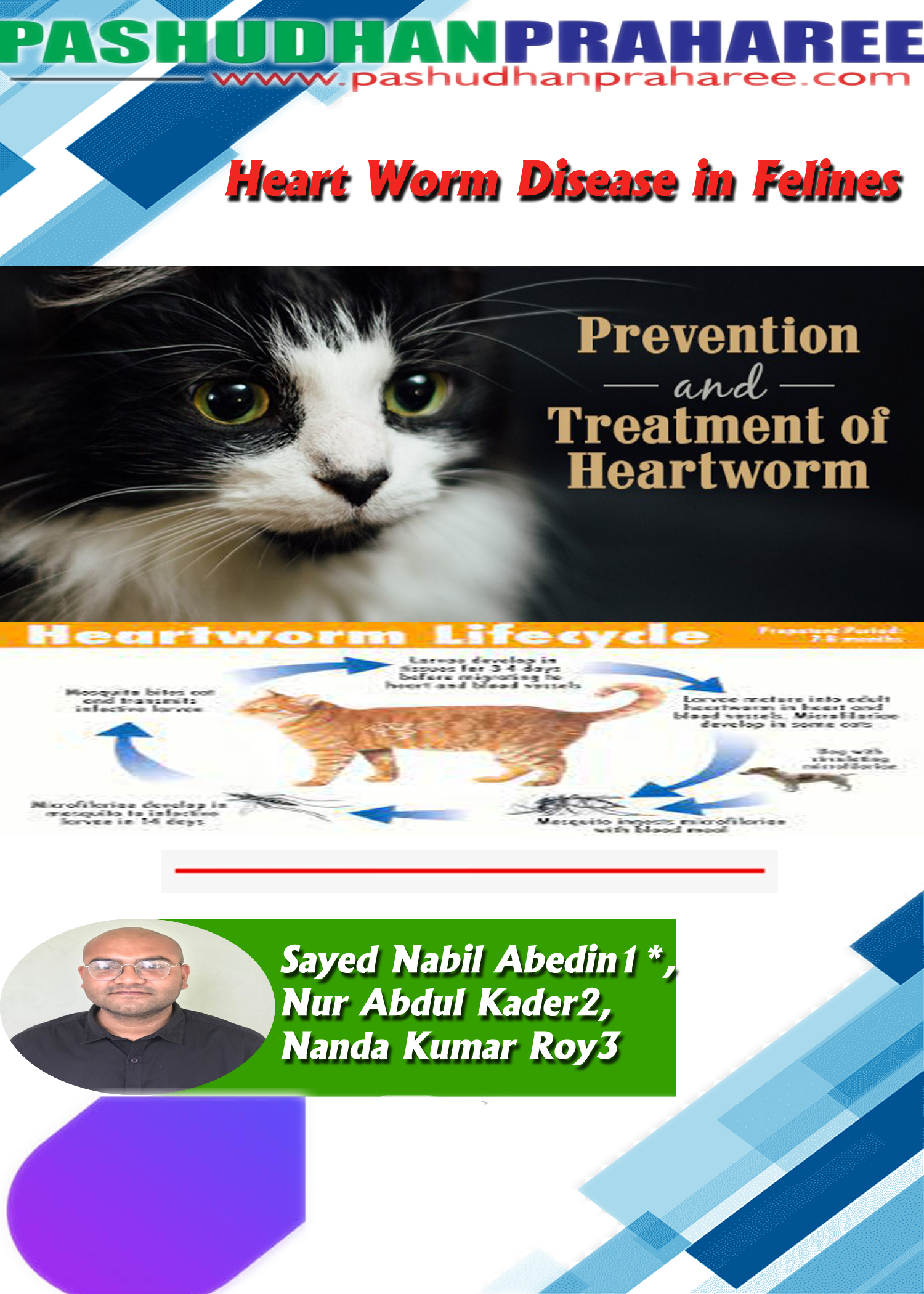Heart Worm Disease in Felines
Heart worms are a blood borne parasite called Dirofilaria immitis that reside in the heart or adjacent large vessels of infected animals. The male worm is about half the size of females. Typically, cats have fewer adult worms than dogs, usually less than 6. Heartworm disease in cats is very different from heartworm disease in dogs. The cat is an atypical host for heartworms, and most worms in cats do not survive to the adult stage. Cats with adult heartworms typically have just one to three worms, and many cats affected by heartworms have no adult worms. While this means heartworm disease often goes undiagnosed in cats, it’s important to understand that even immature worms cause real damage in the form of a condition known as heartworm associated respiratory disease (HARD). Moreover, the medication used to treat heartworm infections in dogs cannot be used in cats, so prevention is the only means of protecting cats from the effects of heartworm disease.
Etiology: Dirofilaria immitis
Epidemiology
Geographical prevelance of feline heartworm infection generally follows canine infections,but infection occurs at approximately 10% of the prevelance rate for dogs. Cats are infected with juvenile worms at a much higher rate than with adult worms.
- immitis can be found in warm climate. An optimum temperature of 25-27 degrees and rainfall and humidity determine the prevelance of mosquitoes and the number of heartworm larvae they carry. The prevelance of feline heartworm is considered to be 9-18% of the prevelance of canine heartworm in a given area.
Life cycle of heartworm in cats
Mosquito feeds on infected, ingesting microfilaria with blood. Microfilaria matures in mosquito to infective L3 larvae (2 weeks post infection). Infective larvae gets deposited during subsequent bites and migrates through wound and into host. L3 stage mature to L4 in subcutaneous tissue (1-3 days). L4 migrate through tissues and mature to sexually immature adults (50-70 days). Sexually immature worms migrate to heart and lungs (as early as 70 days post infection). Worms develop to sexual maturity in the pulmonary artery.
Host association and transmission between hosts
More than 70 species of mosquitoes are capable of transmitting D. immitis but only 22 species are common and have important vectors. L3 larvae taken from mosquitoes that had fed on experimentally infected cats were capable of infecting kittens. Cats are a dead end host for D. immitis.
Pathophysiology
The presence of adult worms in the heart leads to thickening of vessel walls and subsequent pulmonary hypertension. Histopathological changes in the vessels infected with heartworm include fibrosis, hypertrophy and thrombosis. Sustained hypertension can lead to right sided heart failure. Pulmonary parenchymal damage also occurs as a result of thrombosis caused by embolism of dead worms. This leads to lung damage. Not all worms migrate to heart, some reside in abdominal cavity, eye, spinal cord and brain.
Clinical signs
Signs of heartworm disease in cats can be very subtle or very dramatic. Symptoms may include coughing, asthma-like attacks, periodic vomiting, lack of appetite, or weight loss. Occasionally an affected cat may have difficulty walking, experience fainting or seizures, or suffer from fluid accumulation in the abdomen. Unfortunately, the first sign in some cases is sudden collapse of the cat, or sudden death.
Diagnosis
- History
- Clinical signs
- Microfilarial identification: Fewer than 20% of cats with mature heartworm are microfilaremic. Because of the absence of microfilaria, techniques such as modified Knott technique, direct blood smear are less useful.
4) Clinical pathology-
- mild non regenerative anaemia
- eosinophilia
- basophilia
- neutrophilia
- thrombocytopenia
- liver enzyme elevation
- azotemia
- hyperbilirubinemia
- proteinuria
5) The heartworm antibody test
6) The heartworm antigen test
7) Radiography- Enlargement of right caudal lobar artery and a bronchointerstitial inflammatory pattern in the caudal lung lobes.
Treatment
- Infected cats with radiographic signs of pulmonary interstitial lung disease can be treated with a dose of 2mg/kg per day and reducing to 0.5mg/kg every other day with Prednisone.
- Melassomine dihydrocloride unlike in dogs are not used in cats.
- Adulticide treatment with acetarsamide @2.2mg/kg I/Vly Bid for 2 days
- Symptomatic treatment with corticosteroids to decrease dyspnoea, coughing and wheezing caused by juvenile worms.
- Bronchodilators
- Emergency treatment of symptomatic cats-
- Parenteral corticosteroids
- Oxygen therapy
- Xanthine Bronchodilators (theophylline)
Control and Prevention
- Available preventives for cats include oral ivermectin, topical moxidectin/ imidacloprid or topical Salamectin.
- Control of mosquito vectors.
- Available preventives for cats include-
- HEARTGARD® (ivermectin)
- Revolution® (Salamectin)
- Advantage Multi® (imidacloprid/moxidectin)
- A year round heartworm prevention programme should be followed.
Summary
Heartworm infection in cats is primarily pulmonary in nature. Infected cats can be asymptomatic carriers of the parasite or can present non-specific clinical signsd, most frequently respiratory or digestive in origin. Some infected cats die suddenly without any premonitory signs. When signs of infection are evident they typically develop during the arrival of immature adult heartworms into the pulmonary vasculature and during the subsequent death of some of these worms, and signs may develop during the death of adult heartworms. There are always higher infection and prevalence rates in outdoor cats which reflect a conducive climate for the vectors and their potential to transmit filarial infections like other bacterial, viral and protozoal infections of man and animals.
Sayed Nabil Abedin1*, Nur Abdul Kader2, Nanda Kumar Roy3
1PhD Scholar, Deptt. of Veterinary Physiology, College of Veterinary Science, AAU, Khanapara, Ghy-22
2PhD Scholar, Deptt. of Veterinary Public Health, College of Veterinary Science, AAU, Khanapara, Ghy-22
3PhD Scholar, Deptt. of Livestock Production & Management, College of Veterinary Science, AAU, Khanapara, Ghy-22
*Corresponding author, Email- sayedna14@gmail.com
References
- Heartworm disease in dogs and cats by RAWLINGS.
- org/heartworm-in-cats.



